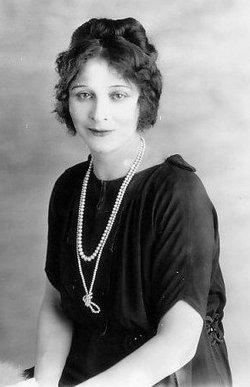Cleo Madison (Lulu Bailey)

Cleo Madison began her acting career on stage with the Santa Barbara Stock Company. She made her first professional appearances on the stages of the Burbank Theatre and the Belasco in 1911. She played the role of the mother in Captain Swift. In March 1912 she debuted as the leading female player in Ernest Shipman’s stock company in Phoenix, Arizona; her first production was When We Were Twenty-One. She toured on vaudeville briefly. In 1913 Madison signed with Universal Pictures and achieved star status the following year in The Trey o’ Hearts (1914), a 15-episode film serial for Universal. Cleo Madison played three roles in the serial, portraying both the protagonist, Judith Trine, and the villain, her evil twin Rose, as well as the twins’ mother. Cleo Madison’s performances were based on an acting style she developed during her time as a vaudeville performer, relying on large gestures and melodramatic facial expressions. She did not avoid physical exertion in pursuit of convincing portrayal, as demonstrated in The Trey of Hearts (1914) in which her character endured a number of physical challenges such as being in a car crash, being shot at, and escaping a forest fire. Her characters often defied stereotypical roles of women in film and encompassed heroines, free-thinkers, villains, temptresses, and adventurers. Madison’s acting style employed her total commitment and passion to each role, and her performances were often acclaimed as such. Journalist William M. Henry, writing for Photoplay, highlighted her skill by contrasting her emotional performances with her calculating and business-like persona in real-life: “… to see Madison in pictures tells you absolutely nothing about her character. Before the camera she smiles and weeps with the wonderful sympathy of which only a woman is capable.”
By 1915, Cleo Madison had become well known as one of the foremost women working in Hollywood, and she began to seek new challenges within the industry such as screenwriting, producing, and directing. Madison directed sixteen shorts and two feature-length films in a directorial career lasting only one year. Her most notable credits included the short films Her Defiance (1916), Eleanor’s Catch (1916), and Triumph of Truth (1916). Eleanor’s Catch was notable from a directorial perspective as one of the first films to use the twist ending;[citation needed] in it, Madison as the heroine is ultimately revealed to be an undercover government agent. Both of Madison’s feature film efforts have been praised in recent history by film historians; Her Bitter Cup (1916) is the underdog tale of unionized workers led by Madison’s character staging a protest against their oppressive boss. A Soul Enslaved (1916) features a desperate heroine becoming a rich man’s mistress to escape poverty, and afterward suffering the consequences of her actions in a later, conventional relationship. Madison’s role as director allowed her to incorporate themes previously ignored by mainstream Hollywood[clarification needed] such as oppression, sexuality, and power from a female perspective.[citation needed] She believed being female positively influenced her directing style, remarking once that each of her directed pieces had to have a certain “feminine touch”. Madison’s directorial credits end after 1916 for unknown reasons, although film historians have speculated that her status and workload led to a nervous breakdown that forced her into an early retirement.
Reports in 1916–1917 indicated she was forming a production company with Isadore Bernstein which ultimately failed to materialize; in 1919 she was again reported to be forming her own production studio. During these years she continued to act in films such as Black Orchids (1917), The Romance of Tarzan (1918), The Girl From Nowhere (1919) and The Great Radium Mystery (1919). By the early 1920s, Cleo Madison’s career had been steadily declining. Although she remained active with bit parts in several Universal shorts, she no longer possessed the star power necessary to inhabit lead roles. Many film historians point to her enormous output of work throughout the mid-1910s as a cause of exhaustion and exasperation for Madison. She was rumored to have suffered a nervous breakdown in 1922, attempted a career-comeback in 1923, and by 1924 had permanently withdrawn from the film industry. After leaving the film industey, she lived her remaining years in California with her husband, Don Peake. In 1964, Cleo Madison suffered a heart-attack and died at the age of 80. She is buried in Glendale’s Grand View Memorial Park Cemetery.
Born
- March, 26, 1883
- USA
- Bloomington, Illinois
Died
- March, 11, 1964
- USA
- Burbank, California
Cause of Death
- heart attack
Cemetery
- Grand View Memorial Park
- Glendale, California
- USA



